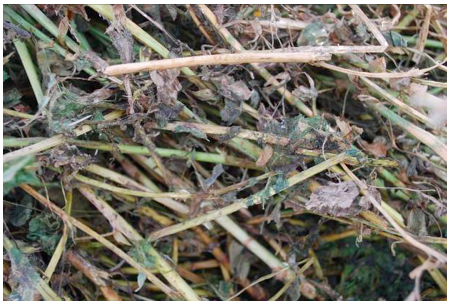While not always on the forefront of our mind, mold in hay can be a problem for livestock. Particularly in years like 2021, where we have had a lot of moisture and humidity during harvest. Not only did the wet summer we had increase our chances of mold, but it made producing quality hay more difficult. The biggest factor contributing to digestibility in hay is the growth stage in which it was cut. Although it may seem strange, years when it is very wet can be just as difficult on a hay producer as years when it is very dry. It is harder to get in the field to actually harvest a crop. When we have a shortage of hay, many producers are forced to feed less than ideal quality hay and mold can once again become a challenge.

Mold can grow on hay with moisture levels above 14-15%. Mold growth produces heat and can result in large amounts of dry matter and TDN (total digestible nutrients) loss. In some cases, that heating can be enough to cause spontaneous combustion and fire. Drying of stored hay is enhanced by increased ventilation, creating air spaces between bales, and reducing stack size. However, dry hay will draw moisture from humid conditions, particularly on the outer 6-12” of the exposed surface. Any moisture level above 20% on the surface can result in mold growth and levels greater than 30% can result in the stack’s entire surface becoming covered in black sooty mold.
Molds are more of a hazard in non-ruminant animals than in ruminants. Horses, in particular, are noted as being susceptible to moldy forages. Mold can cause respiratory issues such as RAO (recurrent airway obstruction) and is thought to be a contributing factor to COPD (Chronic Obstructive Pulmonary Disorder) which is commonly known as heaves. This is doubly true if forage is not fed in a well ventilated area or if it is extremely dusty. Increased mold growth can cause what we describe as “dusty” hay as well. Feeding or keeping horses outside can help cut down on the effects of duty or moldy hay. Mold can cause significantly higher rate of digestive upset or colic issues in horses due to the anatomy of their digestive tract. Colic is one of the most common illnesses in horses, so eliminating moldy hay from a diet greatly decreases the possibility of colic in your herd. Slightly to moderately moldy hay, (spore counts up to 1 million cfu/gram) is relatively safe if fed to cattle and small ruminants. While cattle are less affected by mold, certain molds can cause abortions or aspergillosis.
For more information on hay quality and forage testing contact your local UGA Extension Agent.